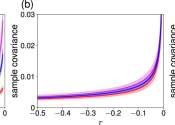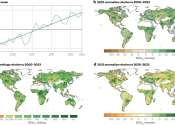Study shows climate change impact on China's dry–wet transition zones
Climate change is significantly altering bioclimatic environments in China's dry–wet transition zones, according to a recent study published in the Journal of Hydrology.

Climate change is significantly altering bioclimatic environments in China's dry–wet transition zones, according to a recent study published in the Journal of Hydrology.
Earth Sciences
18 hours ago
0
8

Whether you're trying to predict a climate catastrophe or mental health crisis, mathematics tells us to look for fluctuations.
Mathematics
19 hours ago
0
122

In the last several decades, large forest fires have increasingly threatened communities across the Mediterranean. Climate change is expected to make these fires larger, hotter, and more dangerous in the future. But fire ...
Environment
19 hours ago
0
14

The hyper-arid desert of Eastern Sudan, the Atbai Desert, seems like an unlikely place to find evidence of ancient cattle herders. But in this dry environment, my new research has found rock art over 4,000 years old that ...
Archaeology
19 hours ago
0
24

California may be a leader in the fight against climate change, but the state is years, even decades, behind other states when it comes to granting environmental rights to its citizens.
Environment
20 hours ago
0
48

Fungal disease Fusarium head blight (FHB) is on the rise due to increasingly humid conditions induced by climate change during the wheat growing season, but a fundamental discovery by University of Adelaide researchers could ...
Molecular & Computational biology
22 hours ago
0
10

The deterioration of the UK's natural environment could lead to an estimated 12% loss to GDP, according to new analysis. In comparison, the financial crisis of 2008 took around 5% off the value of the UK GDP, while the COVID-19 ...
Economics & Business
Apr 25, 2024
0
24

In the ongoing quest to track the progression of climate change, scientists frequently examine the state of our planet's vegetation—forests, grasslands, agricultural lands, and beyond.
Earth Sciences
Apr 25, 2024
0
9

New University of Minnesota research suggests "leaf glow" provides vital information on vegetation dynamics in Arctic and boreal ecosystems like Minnesota's forests and wetlands, which are among the fastest warming in the ...
Plants & Animals
Apr 25, 2024
0
13

Understanding why some people trust some scientists more than others is a key factor in solving social problems with science. But little was known about the trust levels across the diverse range of scientific fields and perspectives.
Social Sciences
Apr 25, 2024
0
408
Climate encompasses the statistics of temperature, humidity, atmospheric pressure, wind, rainfall, atmospheric particle count and numerous other meteorological elements in a given region over long periods of time. Climate can be contrasted to weather, which is the present condition of these same elements over periods up to two weeks.
The climate of a location is affected by its latitude, terrain, altitude, ice or snow cover, as well as nearby water bodies and their currents. Climates can be classified according to the average and typical ranges of different variables, most commonly temperature and rainfall. The most commonly used classification scheme is the one originally developed by Wladimir Köppen. The Thornthwaite system, in use since 1948, incorporates evapotranspiration in addition to temperature and precipitation information and is used in studying animal species diversity and potential impacts of climate changes. The Bergeron and Spatial Synoptic Classification systems focus on the origin of air masses defining the climate for certain areas.
Paleoclimatology is the study and description of ancient climates. Since direct observations of climate are not available before the 19th century, paleoclimates are inferred from proxy variables that include non-biotic evidence such as sediments found in lake beds and ice cores, and biotic evidence such as tree rings and coral. Climate models are mathematical models of past, present and future climates.
This text uses material from Wikipedia, licensed under CC BY-SA